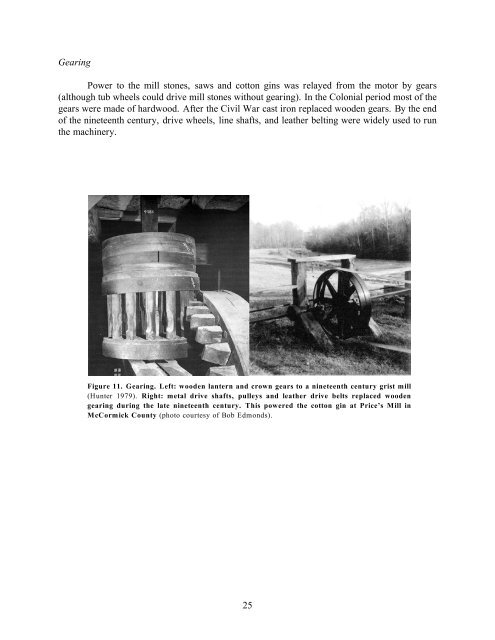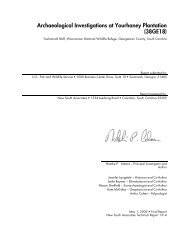Mills in the Upcountry: a Historic Context, and a Summary of a Mill ...
Mills in the Upcountry: a Historic Context, and a Summary of a Mill ...
Mills in the Upcountry: a Historic Context, and a Summary of a Mill ...
You also want an ePaper? Increase the reach of your titles
YUMPU automatically turns print PDFs into web optimized ePapers that Google loves.
Gear<strong>in</strong>g<br />
Power to <strong>the</strong> mill stones, saws <strong>and</strong> cotton g<strong>in</strong>s was relayed from <strong>the</strong> motor by gears<br />
(although tub wheels could drive mill stones without gear<strong>in</strong>g). In <strong>the</strong> Colonial period most <strong>of</strong> <strong>the</strong><br />
gears were made <strong>of</strong> hardwood. After <strong>the</strong> Civil War cast iron replaced wooden gears. By <strong>the</strong> end<br />
<strong>of</strong> <strong>the</strong> n<strong>in</strong>eteenth century, drive wheels, l<strong>in</strong>e shafts, <strong>and</strong> lea<strong>the</strong>r belt<strong>in</strong>g were widely used to run<br />
<strong>the</strong> mach<strong>in</strong>ery.<br />
Figure 11. Gear<strong>in</strong>g. Left: wooden lantern <strong>and</strong> crown gears to a n<strong>in</strong>eteenth century grist mill<br />
(Hunter 1979). Right: metal drive shafts, pulleys <strong>and</strong> lea<strong>the</strong>r drive belts replaced wooden<br />
gear<strong>in</strong>g dur<strong>in</strong>g <strong>the</strong> late n<strong>in</strong>eteenth century. This powered <strong>the</strong> cotton g<strong>in</strong> at Price’s <strong>Mill</strong> <strong>in</strong><br />
McCormick County (photo courtesy <strong>of</strong> Bob Edmonds).<br />
25







